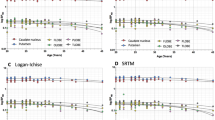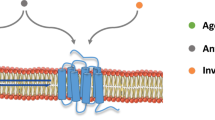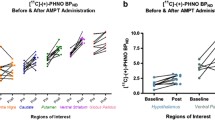Summary
Affinities and regional densities of the D1- and D2-dopamine receptor subtypes were studied in the human post-mortem brain in vitro using the two selective radioligands3H-SCH23390 and3H-raclopride.3H-Raclopride binding was confined to the caudate nucleus, the putamen and the substantia nigra, while3H-SCH23390 bound to cortical regions as well. The binding of3H-SCH 23390 was reduced by a low concentration of ketanserin, indicating binding to 5-HT2 receptors in addition to the D1dopamine receptors. The endogenous neurotransmitter dopamine interacted potently both with the D1-dopamine receptor and the D2-dopamine receptor, displaying two affinity states for each subtype. The distribution of the dopamine receptor subtypes obtained in the present in vitro investigation is in agreement with data obtained with11C-SCH 23390 and11C-raclopride in positron emission tomographic studies in human volunteers.
Similar content being viewed by others
References
Amalric M, Koob GF, Creese I, Swerdlow NR (1986) “Selective” D-1 and D-2 receptor antagonists fail to differentially alter supersensitive locomotor behaviour in the rat. Life Sci 39: 1985–1993
Andén NE, Carlsson A, Dahlström A, Fuxe K, Hillarp Nå, Larsson K (1964) Demonstration and mapping out of nigro-neostriatal dopamine neurons. Life Sci 4: 523–530
Andersen PH, Nielsen EB (1986) The dopamine D1 receptor: biochemical and behavioural aspects. In: Breese GR, Creese I (eds) Neurobiology of central D1-dopamine receptors. Plenum Press, London, pp 73–91
Aquilonius S-M, EckernÄs S-å, Gillberg P-G (1983) Large section cryomicrotomy in human neuroanatomy and neurochemistry. In: Cuello AC (ed) Brain microdissection techniques. Wiley, Chichester (IBRO handbooks series, Methods in the neurosciences, vol 2, pp 155–170
Barnett A (1986) Review on dopamine receptors. Drugs Fut 11: 49–56
Bannon MJ, Roth H (1983) Pharmacology of mesocortical dopamine neurons. Pharmacol Rev 35: 53–65
Billard W, Ruperto V, Crosby G, Iorio LC, Barnett A (1984) Characterization of the binding of3H-SCH23390, a selective D-1 receptor antagonist ligand, in rat striatum. Life Sci 35: 1885–1893
Bischoff S, Bittiger H, Krauss J (1980) In vivo (3H)spiperone binding to the rat hippocampal formation: involvement of dopamine receptors. Eur J Pharmacol 68: 305–315
Bischoff S, Bittiger H, Delini-Stula A, Ortmann R (1982) Septohippocampal system: target for substituted benzamides. Eur J Pharmacol 79: 225–232
Bischoff S, Heinrich M, Sonntag JM, Krauss J (1986) The D-1 dopamine receptor antagonist SCH23390 also interacts potently with brain serotonin (5-HT2) receptors. Eur J Pharmacol 129: 367–370
Björklund A, Lindvall O (1984) Dopamine-containing systems in the CNS. In: Björklund O, Hökfelt T (eds) Handbook of chemical neuroanatomy, vol 2, classical transmitters in the CNS, part 1. Elsevier, Amsterdam, pp 55–122
Boyson SJ, McGonigle P, Molinoff PB (1986) Quantitative autoradiographic localization of the D1 and D2 subtypes of dopamine receptors in rat brain. J Neurosci 6: 3177–3188
Bruinink A, Bischoff S (1986) Detection of dopamine receptors in homogenates of rat hippocampus and other brain areas. Brain Res 386: 78–83
Creese I, Burt DR, Snyder SH (1976) Dopamine receptor binding predicts clinical and pharmacological potencies of antischizophrenic drugs. Science 192: 481–483
Creese I, Sibley DR, Hamblin MW, Leff SE (1983) The classification of dopamine receptors: relationship to radioligand binding. Ann Rev Neurosci 6: 43–71
Creese I, Sibley DR, Leff SE (1984) Agonist interactions with dopamine receptors: relationship to radioligand binding. Fed Proc 43: 2779–2784
Dawson TM, Gehlert DR, Yamamura HI, Barnett A, Wamsley JK (1985) D-1 dopamine receptors in the rat brain: autoradiographic localization using (3H)-SCH23390. Eur J Pharmacol 108: 323–325
Dawson TM, Gehlert RD, Wamsley JK (1986) Quantitative autoradiographic localization of central dopamine D-1 and D-2 receptors. In: Breese GR, Creese I (eds) Neurobiology of central D1dopamine receptors. Plenum Press, London pp 93–118
Fallon JH, Moore RY (1978) Catecholamine innervation of the basal forebrain. IV. Topography of the dopamine projection to the basal forebrain and neostriatum. J Comp Neurol 180: 545–580
Farde L, Ehrin E, Eriksson L, Greitz T, Hall H, Hedström CG, Litton JE, Sedvall G (1985) Substituted benzamides as ligands for visualization of dopamine receptor binding in the human brain by positron emission tomography. Proc Natl Acad Sci USA 82: 3863–3867
Farde L, Hall H, Ehrin E, Sedvall G (1986) Quantitative analysis of D2 dopamine receptor binding in the living human brain by PET. Science 231: 258–261
Farde L, Halldin C, Stone-Elander S, Sedvall G (1987a) PET analysis of human dopamine receptor subtypes using11C-SCH23390 and11C-raclopride. Psychopharmacology 92: 278–284
Farde L, Wiesel F, Hall H, Halldin C, Stone-Elander S, Sedvall G (1987b) PET reveals unchanged D2-dopamine receptors in drugnaive schizophrenics. Arch Gen Psychiatry 44: 671–672
Fuxe K, ögren SO, Fredholm B, Agnati L, Hökfelt T, Perez de la Mora M (1976) Possibilities of a differential blockade of central monoamine receptors. In: de Ajuriaguerra J, Tissot R (eds) Rhinencéphale neurotransmitteurs et psychoses. Georg & Cie, Geneva, pp 253–289
Gawell L, Hall H, Köhler C (1985) Preparation of tritium labelled benzamide dopamine-D2 ligands at high specific activity. J Labelled Compound Radiopharm 22: 1033–1043
Gehlert DR, Wamsley JK (1984) Autoradiographic localization of (3H)-sulpiride binding sites in the rat rain. Eur J Pharmacol 98: 311–312
Gehlert DR, Wamsley JK (1985) Dopamine receptors in the rat brain: quantitative autoradiographic localization using (3H)-sulpiride. Neurochem Int 7: 717–723
Glowinski J, Tassin JP, Thierry AM (1983) The mesocortico-prefrontal dopaminergic neurons. TINS 6: 415–418
Hall H, Thor L (1979) Evaluation of a semiautomatic filtration technique for receptor binding studies. Life Sci 24: 2293–2300
Hall H, SÄllemark M, Jerning E (1986) Effects of remoxipride and some related new substituted salicylamides on rat brain receptors. Acta Pharmacol Toxicol 58: 61–70
Hall H, Wedel I (1986) Comparisons between the in vitro binding of two substituted benzamides and two butyrophenones to dopamine-D2 receptors in the rat striatum. Acta Pharmacol Toxicol 58: 368–373
Hyttel J (1983) SCH23390—the first selective dopamine D1 antagonist. Eur J Pharmacol 91: 153–154
Hyttel J, Christensen AV (1984) Do dopamine D-1 receptors contribute to the antipsychotic effects and side effects of neuroleptic drugs? Clin Pharmacol [Suppl] 7: 546–547
Kebabian JW, Agui T, van Oene JC, Shigematsu K, Saavedra JM (1986) The D1 dopamine receptor: new perspectives. TIPS 7: 96–99
Kebabian JW, Calne DB (1979) Multiple receptors for dopamine. Nature 277: 93–96
Köhler C, Hall H, ögren SO, Gawell L (1985) Specific in vitro and in vivo binding of3H-raclopride, a potent substituted drug with high affinity for dopamine D-2 receptors in the rat brain. Biochem Pharmacol 34: 2251–2259
Köhler C, RadesÄter A-C (1986) Autoradiographic visualization of dopamine D-2 receptors in the monkey brain using the selective benzamide drug (3H)raclopride. Neurosci Lett 66: 85–90
Leff SE, Chen A, Creese I (1984) Sulpiride isomers exhibit reversed stereospecificity for D-1 and D-2 dopamine receptors in the CNS. Neuropharmacology 23: 589–590
Leysen JE, Niemegeers CJE, Van Nueten JM, Laduron PM (1982) (3H)Ketanserin (R41468), a selective3H-ligand for serotonin2 receptor binding sites—binding properties, brain distribution, and functional role. Mol Pharmacol 21: 301–314
Lindvall O, Björklund A (1974) The organization of the ascending catecholamine neuron systems in the rat brain as revealed by the glyoxylic acid fluorescence method. Acta Physiol Scand [Suppl] 412: 1–48
Martres MP, Bouthenet ML, Sales N, Sokoloff P, Schwartz JC (1985) Widespread distribution of brain dopamine receptors evidenced with (125I) iodosulpride, a highly selective ligand. Science 228: 752–755
Munson PJ, Rodbard D (1980) Ligand: a versatile computerized approach for characterization of ligand-binding systems. Anal Biochem 107: 220–239
Peroutka SJ, Snyder SH (1980) Relationship of neuroleptic drug effects at brain dopamine, serotonin, adrenergic and histamine receptors to clinical potency. Am J Psychiatry 137: 1518–1522
Sedvall G, Farde L, Stone-Elander S, Halldin C (1986) Dopamine D1 receptor binding in the living human brain. In: Breese GR, Creese I (eds) Neurobiology of central D1 dopamine receptors. Plenum Press, London, pp 119–124
Schultz DW, Wyrick SD, Mailman RB (1985)3H-SCH23390 has the characteristics of a dopamine receptor ligand in the rat central nervous system. Eur J Pharmacol 106: 211–212
Seeman P (1980) Brain dopamine receptors. Pharmacol Rev 32: 229–313
Seeman P, Lee T, Chau-Wong M, Wong K (1976) Antipsychotic drug doses and neuroleptic/ dopamine receptors. Nature 261: 717–719
Stoof JC, Kebabian JW (1984) Two dopamine receptors: biochemistry, physiology and pharmacology. Life Sci 35: 2281–2296
Tassin JP, Bockaert J, Blanc G, Stinus L, Thierry AM, Lavielle S, Premont G, Glowinski J (1978) Topographical distribution of dopaminergic innervation and dopaminergic receptors of the anterior cerebral cortex of the rat. Brain Res 106: 241–251
Ullberg S (1977) The technique of whole-body autoradiography: cryosectioning of large specimens. Sci Tools [Suppl]: 2–29
Waddington JL (1986) Behavioural correlates of the action of selective D-1 dopamine receptor antagonists. Impact of SCH23390 and SKF83566, and functionally interactive D-1∶D-2 receptor systems. Biochem Pharmacol 35: 3661–3667
Wagner HN Jr, Burns HD, Dannals RF, Wong DF, Långström B, Duelfer T, Frost JJ, Ravert HT, Links JM, Rosenbloom SB, Lukas SE, Kramer AV, Kuhar MJ (1983) Imaging dopamine receptors in the human brain by positron tomography. Science 221: 1264–1266
Author information
Authors and Affiliations
Rights and permissions
About this article
Cite this article
Hall, H., Farde, L. & Sedvall, G. Human dopamine receptor subtypes—in vitro binding analysis using3H-SCH 23390 and3H-raclopride. J. Neural Transmission 73, 7–21 (1988). https://doi.org/10.1007/BF01244618
Received:
Accepted:
Issue Date:
DOI: https://doi.org/10.1007/BF01244618




